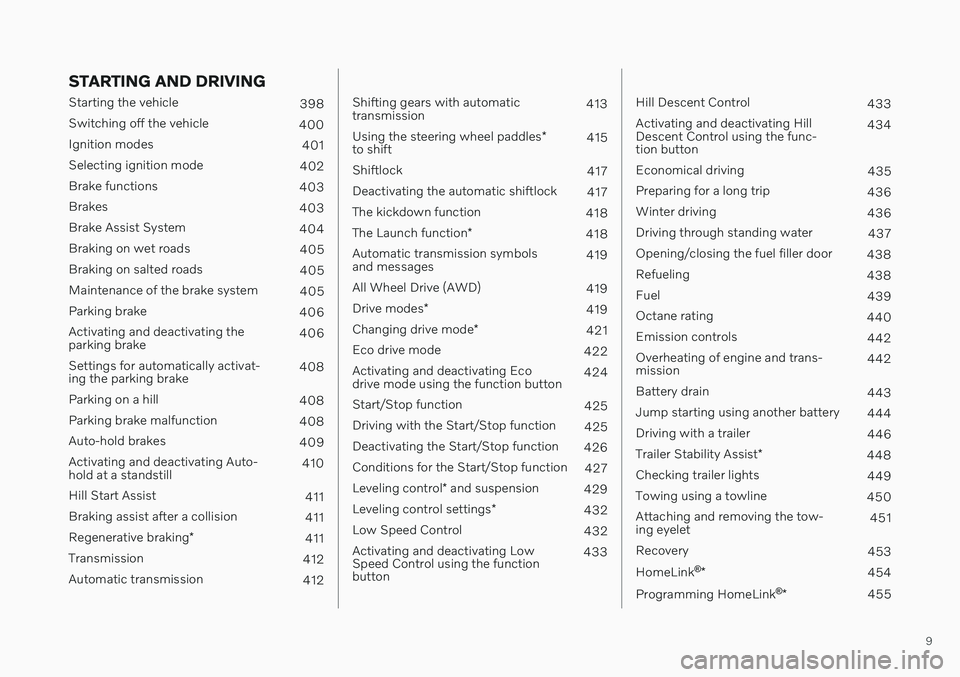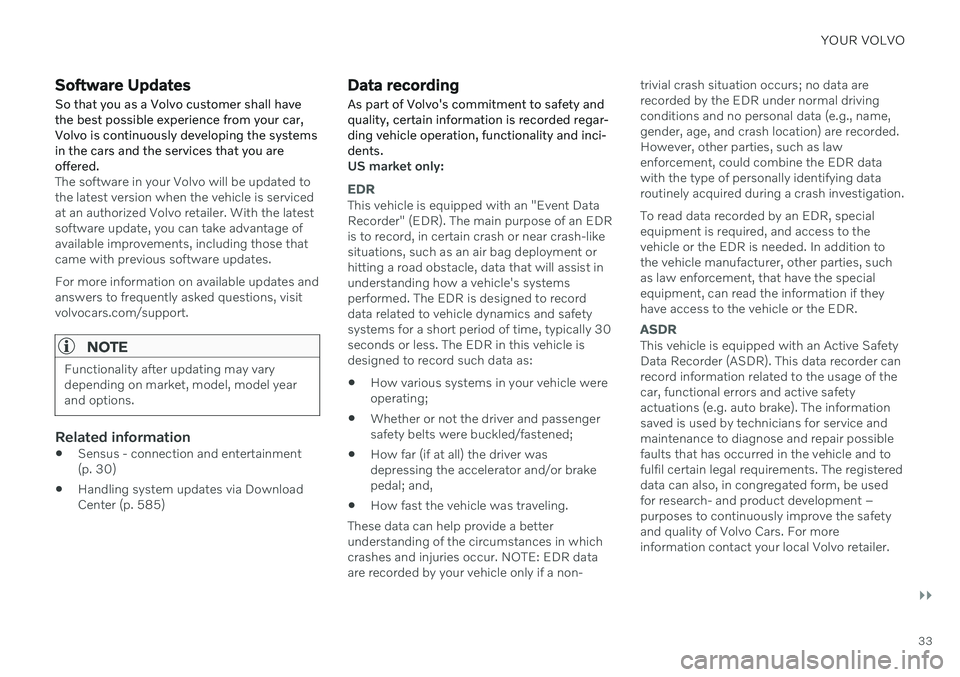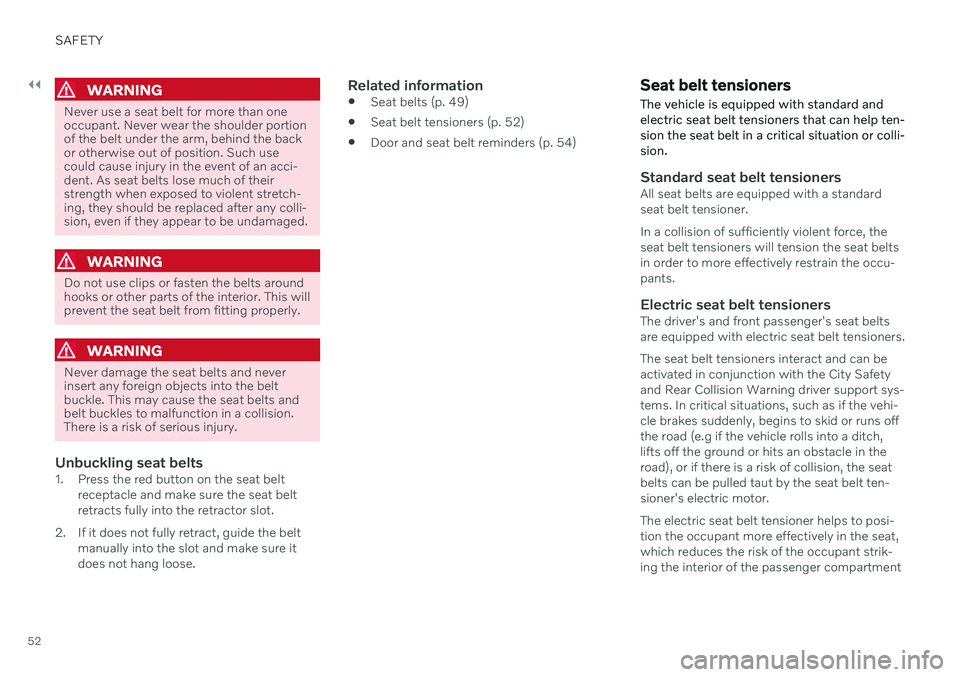2021 VOLVO V90 CROSS COUNTRY brake
[x] Cancel search: brakePage 6 of 683

4
Resetting center display settings138
Table of settings in the center display 139
Driver profiles 140
Selecting a driver profile 141
Changing a driver profile's name 141
Protecting a driver profile 142
Linking a remote key to a driver profile 142
Resetting driver profile settings 143
Messages in the center display 144
Handling messages in the center display 144
Handling messages saved fromthe center display 145
Head-up display *
146
Activating and deactivating the head-up display * 147
Head-up display settings *
148
Voice Control 149
Use voice recognition 150
Voice control for cellular phones 152
Voice control for radio and media 153
Voice control settings 154
LIGHTING
Lighting control and panel156
Adjusting light functions via the center display 157
Parking lights 158
Daytime running lights 158
Low beams 159
Using high beam 160
Active high beam 161
Using turn signals 162
Active Bending Lights *
162
Front fog lights/corner illumination *
163
Rear fog light 164
Brake lights 165
Emergency brake lights 165
Hazard warning flashers 165
Using home safe lighting 166
Welcome Light 166
Interior Lighting 166
Adjusting interior lighting 168
WINDOWS, GLASS AND MIRRORS
Windows, glass and mirrors 172
Pinch protection for windows and sun curtains 172
Reset procedure for pinch protection 173
Power windows 174
Operating the power windows 174
Using sun curtains *
176
Rearview/door mirrors 176
Adjusting the rearview mirror dim-ming function 177
Adjusting the door mirrors 177
Panoramic roof *
179
Operating the panoramic roof *
180
Auto closing the panoramic roof *
sun curtain 182
Wiper blades and washer fluid 183
Using the windshield wipers 183
Using the rain sensor 184
Activating and deactivating therain sensor's memory function 185
Using the windshield and head-light washers 186
Using the rear window wiper/washer 187
Using automatic rear windowwiping when backing up 188
Page 11 of 683

9
STARTING AND DRIVING
Starting the vehicle398
Switching off the vehicle 400
Ignition modes 401
Selecting ignition mode 402
Brake functions 403
Brakes 403
Brake Assist System 404
Braking on wet roads 405
Braking on salted roads 405
Maintenance of the brake system 405
Parking brake 406
Activating and deactivating the parking brake 406
Settings for automatically activat-ing the parking brake 408
Parking on a hill 408
Parking brake malfunction 408
Auto-hold brakes 409
Activating and deactivating Auto-hold at a standstill 410
Hill Start Assist 411
Braking assist after a collision 411
Regenerative braking *
411
Transmission 412
Automatic transmission 412
Shifting gears with automatic transmission413
Using the steering wheel paddles *
to shift 415
Shiftlock 417
Deactivating the automatic shiftlock 417
The kickdown function 418
The Launch function *
418
Automatic transmission symbolsand messages 419
All Wheel Drive (AWD) 419
Drive modes *
419
Changing drive mode *
421
Eco drive mode 422
Activating and deactivating Ecodrive mode using the function button 424
Start/Stop function 425
Driving with the Start/Stop function 425
Deactivating the Start/Stop function 426
Conditions for the Start/Stop function 427
Leveling control * and suspension
429
Leveling control settings *
432
Low Speed Control 432
Activating and deactivating LowSpeed Control using the functionbutton 433
Hill Descent Control
433
Activating and deactivating Hill Descent Control using the func-tion button 434
Economical driving 435
Preparing for a long trip 436
Winter driving 436
Driving through standing water 437
Opening/closing the fuel filler door 438
Refueling 438
Fuel 439
Octane rating 440
Emission controls 442
Overheating of engine and trans-mission 442
Battery drain 443
Jump starting using another battery 444
Driving with a trailer 446
Trailer Stability Assist *
448
Checking trailer lights 449
Towing using a towline 450
Attaching and removing the tow-ing eyelet 451
Recovery 453
HomeLink ®
* 454
Programming HomeLink ®
* 455
Page 15 of 683

13
Fuses in the engine compartment607
Fuses under the glove compartment 612
Fuses in the cargo compartment 618
Replacing bulbs 623
Removing the plastic cover to replace bulbs 624
Location of exterior lights 624
Replacing the low beam headlightbulbs 625
Replacing the high beam headlightbulbs 626
Replacing daytime running lights/front parking light bulbs 626
Replacing front turn signal bulbs 627
Bulb specifications 628
Cleaning the interior 628
Cleaning the center display 629
Cleaning the head-up display * and
instrument panel 630
Cleaning fabric upholstery andceiling liner 630
Cleaning the seat belt 631
Cleaning textile floor and inlay mats 632
Cleaning leather upholstery *
632
Cleaning the leather steering wheel 633
Cleaning interior plastic, metal andwood surfaces 634
Cleaning the exterior
634
Polishing and waxing 635
Hand washing 636
Automatic car washes 637
High-pressure washing 638
Cleaning the wiper blades 639
Cleaning exterior plastic, rubber and trim components 639
Cleaning rims 640
Corrosion protection 641
Paintwork 641
Touching up minor paint damage 642
Color codes 643
Changing rear window wipers 643
Replacing windshield wiper blades 644
Putting the wiper blades in serviceposition 645
Filling washer fluid 646
SPECIFICATIONS
Type designations650
Dimensions 653
Weights 655
Towing capacity and tongue weight 656
Engine specifications 657
Engine oil specifications 658
Transmission fluid specifications 658
Brake fluid specifications 659
Fuel tank volume 659
Air conditioning specifications 659
Approved tire pressure 661
Page 30 of 683

YOUR VOLVO
* Option/accessory.
28
Drive-E ‒ purer driving pleasure
Volvo is committed to the well-being of its customers. As a natural part of this commit-ment, we care about the environment inwhich we all live. Concern for the environ-ment means an everyday involvement inreducing our environmental impact.
Volvo's environmental activities are based on a holistic view, which means we consider theoverall environmental impact of a productthroughout its complete life cycle. In this con-text, design, production, product use, andrecycling are all important considerations. Inproduction, Volvo has partly or completelyphased out several chemicals including CFCs,lead chromates, asbestos, and cadmium; andreduced the number of chemicals used in ourplants 50% since 1991. Volvo was the first in the world to introduce into production a three-way catalytic converterwith a Lambda sond, now called the heatedoxygen sensor, in 1976. The current version ofthis highly efficient system reduces emissionsof harmful substances (CO, HC, NOx) from theexhaust pipe by approximately 95 - 99% andthe search to eliminate the remaining emis-sions continues. Volvo is the only automobilemanufacturer to offer CFC-free retrofit kits forthe air conditioning system of all models as farback as the 1975 model 240. Advanced elec-tronic engine controls and cleaner fuels arebringing us closer to our goal. In addition to continuous environmental refinement of con-ventional gasoline-powered internal combus-tion engines, Volvo is actively looking atadvanced technology alternative-fuel vehicles. When you drive a Volvo, you become our part- ner in the work to lessen the vehicle's impacton the environment. To reduce your vehicle'senvironmental impact, you can:
Maintain proper air pressure in your tires.Tests have shown decreased fuel econ-omy with improperly inflated tires.
Follow the recommended maintenanceschedule in your Warranty and ServiceRecords Information booklet.
Drive at a constant speed whenever possi-ble.
See a trained and qualified Volvo servicetechnician as soon as possible for inspec-tion if the check engine (malfunction indi-cator) light illuminates, or stays on afterthe vehicle has started.
Properly dispose of any vehicle-relatedwaste such as used motor oil, used batter-ies, brake pads, etc.
When cleaning your vehicle, please usegenuine Volvo car care products. All Volvocar care products are formulated to beenvironmentally friendly.
Related information
Economical driving (p. 435)
Starting and stopping preconditioning
*
(p. 234)
The Owner's Manual and the environment(p. 23)
Air quality (p. 209)
Page 35 of 683

YOUR VOLVO
}}
33
Software Updates
So that you as a Volvo customer shall have the best possible experience from your car,Volvo is continuously developing the systemsin the cars and the services that you areoffered.
The software in your Volvo will be updated to the latest version when the vehicle is servicedat an authorized Volvo retailer. With the latestsoftware update, you can take advantage ofavailable improvements, including those thatcame with previous software updates. For more information on available updates and answers to frequently asked questions, visitvolvocars.com/support.
NOTE
Functionality after updating may vary depending on market, model, model yearand options.
Related information
Sensus - connection and entertainment (p. 30)
Handling system updates via DownloadCenter (p. 585)
Data recording As part of Volvo's commitment to safety and quality, certain information is recorded regar-ding vehicle operation, functionality and inci-dents.
US market only:
EDR
This vehicle is equipped with an "Event Data Recorder" (EDR). The main purpose of an EDRis to record, in certain crash or near crash-likesituations, such as an air bag deployment orhitting a road obstacle, data that will assist inunderstanding how a vehicle's systemsperformed. The EDR is designed to recorddata related to vehicle dynamics and safetysystems for a short period of time, typically 30seconds or less. The EDR in this vehicle isdesigned to record such data as:
How various systems in your vehicle wereoperating;
Whether or not the driver and passengersafety belts were buckled/fastened;
How far (if at all) the driver wasdepressing the accelerator and/or brakepedal; and,
How fast the vehicle was traveling.
These data can help provide a betterunderstanding of the circumstances in whichcrashes and injuries occur. NOTE: EDR dataare recorded by your vehicle only if a non- trivial crash situation occurs; no data arerecorded by the EDR under normal drivingconditions and no personal data (e.g., name,gender, age, and crash location) are recorded.However, other parties, such as lawenforcement, could combine the EDR datawith the type of personally identifying dataroutinely acquired during a crash investigation. To read data recorded by an EDR, special equipment is required, and access to thevehicle or the EDR is needed. In addition tothe vehicle manufacturer, other parties, suchas law enforcement, that have the specialequipment, can read the information if theyhave access to the vehicle or the EDR.
ASDR
This vehicle is equipped with an Active Safety Data Recorder (ASDR). This data recorder canrecord information related to the usage of thecar, functional errors and active safetyactuations (e.g. auto brake). The informationsaved is used by technicians for service andmaintenance to diagnose and repair possiblefaults that has occurred in the vehicle and tofulfil certain legal requirements. The registereddata can also, in congregated form, be usedfor research- and product development –purposes to continuously improve the safetyand quality of Volvo Cars. For moreinformation contact your local Volvo retailer.
Page 36 of 683

||
YOUR VOLVO
34Canadian market only: This vehicle is equipped with an “Event Data Recorder” (EDR). The main purpose of theEDR is to register and record data in trafficaccidents or accident-like situations, e.g. if anairbag deploys or if the vehicle hits an obstaclein the road. This data is recorded in order tohelp understand how the vehicle's systemsperform in these types of situations. The EDRis designed to record data related to vehicledynamics and safety systems for a shortperiod of time, usually 30 seconds or less. The EDR in this vehicle is designed to record data in traffic accidents or accident-like situa-tions such as:
How the various systems in the vehicleperformed;
Whether the driver and passenger seatbelts were tightened/buckled;
The driver's use of the accelerator/brakepedal;
How fast the vehicle was moving.
This data can help provide a better under-standing of the circumstances in which trafficaccidents and injuries occur. The EDR records data only if a non-trivial accident situation occurs. EDR does not record any data duringnormal driving conditions. The system alsonever registers data on who is driving the vehi-cle or the geographical location of the acci- dent or near-accident. However, other parties,such as law enforcement, could combine theEDR data with the type of personally identifia-ble information that is routinely acquired dur-ing an accident investigation. Special equip-ment and access to either the vehicle or theEDR is required to read this recorded data. In addition to the EDR, the vehicle is equipped with a number of computers that continuouslycontrol and monitor the vehicle's performance.These computers may record data during nor-mal driving conditions, particularly if theydetect a fault relating to the vehicle's opera-tion and functionality or upon activation of thevehicle's active driver support functions (e.g.City Safety or the auto-brake function). Some of this recorded data is required by technicians performing service and mainte-nance in order to diagnose and rectify anyfaults that may have occurred in the vehicle.The recorded information is also needed toenable Volvo to fulfill legal and other regula-tory requirements. Information registered inthe vehicle is stored in its computers until thevehicle is serviced or repaired. In addition to the above, the recorded informa- tion may be used in aggregated form forresearch and product development purposesin order to continuously improve the safetyand quality of Volvo vehicles.
Volvo will not provide this information to anythird parties without the vehicle owner's con-sent. However, national legislation and regula-tions may require Volvo to disclose this type ofinformation to law enforcement or otherauthorities that can claim a legal right to theinformation. Special technical equipment,which Volvo and workshops that have enteredagreements with Volvo have access to, isrequired to read and interpret the recordeddata. Volvo is responsible for ensuring thatinformation provided to Volvo in conjunctionwith service and maintenance is stored andhandled securely and in compliance withapplicable legal requirements. For more infor-mation, please contact a Volvo retailer.
Vehicle Connectivity Module (VCM
High)
Vehicles equipped with VCM High can collectdata on the vehicle's safety functions as wellas other functions in the vehicle. This data iscollected for product development, quality fol-low-up, safety work and to improve and moni-tor the vehicle's quality and its safety func-tions. Data is also collected in order to man-age Volvo Cars' warranty commitments and tocomply with legal requirements related toengine emission data.
Page 54 of 683

||
SAFETY
52
WARNING
Never use a seat belt for more than one occupant. Never wear the shoulder portionof the belt under the arm, behind the backor otherwise out of position. Such usecould cause injury in the event of an acci-dent. As seat belts lose much of theirstrength when exposed to violent stretch-ing, they should be replaced after any colli-sion, even if they appear to be undamaged.
WARNING
Do not use clips or fasten the belts around hooks or other parts of the interior. This willprevent the seat belt from fitting properly.
WARNING
Never damage the seat belts and never insert any foreign objects into the beltbuckle. This may cause the seat belts andbelt buckles to malfunction in a collision.There is a risk of serious injury.
Unbuckling seat belts1. Press the red button on the seat beltreceptacle and make sure the seat belt retracts fully into the retractor slot.
2. If it does not fully retract, guide the belt manually into the slot and make sure itdoes not hang loose.
Related information
Seat belts (p. 49)
Seat belt tensioners (p. 52)
Door and seat belt reminders (p. 54)
Seat belt tensioners The vehicle is equipped with standard and electric seat belt tensioners that can help ten-sion the seat belt in a critical situation or colli-sion.
Standard seat belt tensionersAll seat belts are equipped with a standard seat belt tensioner. In a collision of sufficiently violent force, the seat belt tensioners will tension the seat beltsin order to more effectively restrain the occu-pants.
Electric seat belt tensionersThe driver's and front passenger's seat beltsare equipped with electric seat belt tensioners. The seat belt tensioners interact and can be activated in conjunction with the City Safetyand Rear Collision Warning driver support sys-tems. In critical situations, such as if the vehi-cle brakes suddenly, begins to skid or runs offthe road (e.g if the vehicle rolls into a ditch,lifts off the ground or hits an obstacle in theroad), or if there is a risk of collision, the seatbelts can be pulled taut by the seat belt ten-sioner's electric motor. The electric seat belt tensioner helps to posi- tion the occupant more effectively in the seat,which reduces the risk of the occupant strik-ing the interior of the passenger compartment
Page 66 of 683

||
SAFETY
64
Related information
Airbags (p. 55)
Safety mode Safety mode is a feature that is triggered after a collision if there is potential damage toan important function in the vehicle, such asthe fuel lines, sensors for one of the safetysystems, the brake system, etc.
If the vehicle has been involved in a collision, the text Safety mode See Owner's manualmay appear in the instrument panel along with the warning symbol if the panel is undamagedand the vehicle's electrical system is intact.The message indicates that one or more of thevehicle's functions may be reduced.
WARNING
Never attempt to restart the vehicle if you smell fuel fumes when the message Safety
mode See Owner's manual is displayed
in the instrument panel. Leave the vehicle immediately.
If safety mode has been set, it may be possi- ble to reset the system in order to start andmove the vehicle a short distance, for exam-ple, if it is blocking traffic.
WARNING
Never attempt to perform repairs or reset electrical components on your own afterthe vehicle has been in safety mode. Thiscould result in injury or prevent the vehiclefrom functioning properly. Volvo recom-mends having the vehicle inspected andreset to normal operating status by an authorized Volvo workshop after
Safety
mode See Owner's manual has been dis-
played.
WARNING
When the vehicle is in safety mode, it should not be towed behind another vehi-cle. It should be towed from the site on atow truck. Volvo recommends towing thevehicle directly to an authorized Volvoworkshop.
Related information
Safety (p. 44)
Starting and moving the vehicle when it is in safety mode (p. 65)
Recovery (p. 453)